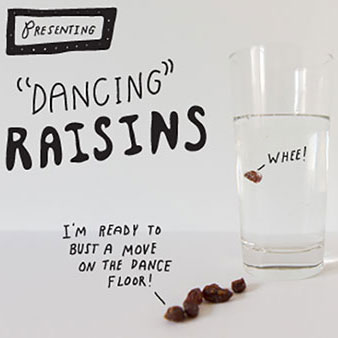
You Will Need
Clear carbonated liquid (sparkling water or clear soda work well)
Raisins
Tall clear glass
Directions
- Fill the glass 3/4 full with the carbonated liquid. Make some observations. What do you see?
- Now drop a raisin into the glass. What do you notice? At first, the raisin sinks, but then something changes. What’s happening?
- Look closely at the raisin and make some more observations. What do you see all over the raisin? What happens next? Who taught that raisin how to dance?
How it works
This experiment demonstrates how an object’s density can change. At first, the raisin sinks because its density is greater than the carbonated liquid. Then the carbon dioxide bubbles stick to all of the little creases of the raisin and increase the raisin’s volume. This helps it to displace more liquid and up it goes! Its density is now less than the liquid and it floats to the top. Once it reaches the top, the gas bubbles pop, the raisin’s volume decreases, and it falls back down and the cycle starts all over again.
Displacement is what happens to the liquid when an object gets dropped in. Think about when you get into the bathtub - have you ever noticed that the water level rises after you get in? You are now taking up space in the tub, and the water has to move out of the way or get displaced, in order to make room for you.
Key Words
- Volume
- The amount of space an object occupies
- Mass
- How much the molecules of an object weigh
- Density
- How compact the molecules of an object are
- Displacement
- The removal of something from its place by something which then occupies that place
